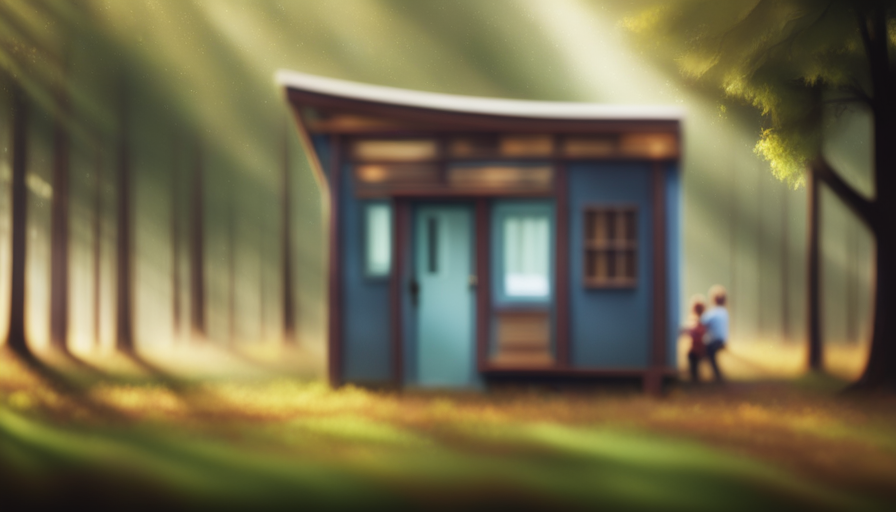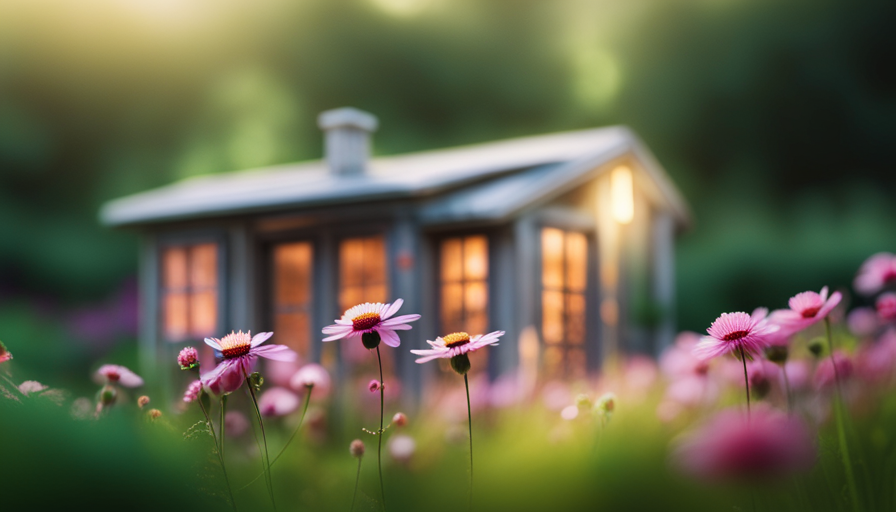Have you ever experienced being the central hub for a bustling community of tiny ants? It’s akin to observing a finely tuned orchestra as these industrious insects scurry about, each one diligently carrying out their designated tasks.
As an entomologist, I am often intrigued by the intricate world of ants that can exist right under our noses. From the minuscule black garden ant to the elusive pharaoh ant, these tiny invaders can be a nuisance in our homes.
But fear not, for in this article, I will unravel the mystery of these tiny ants and provide you with the knowledge to combat their presence. Through detailed observations and scientific terminology, we will explore the various types of tiny ants that may infest your abode, their nesting habits, and food preferences.
I will also delve into prevention measures, natural remedies, and chemical ant control options to help you maintain an ant-free home.
So, let us embark on this entomological adventure and discover the secrets of the tiny ants in your house.
Key Takeaways
- Different types of tiny ants may infest your home, including the odorous house ant and the pavement ant.
- Signs of ant infestation include trails of ants near food sources and piles of dirt near nests.
- Ant colonies consist of queens, workers, and soldiers with specific roles and responsibilities.
- Prevention measures such as keeping the kitchen clean and sealing off entry points are important for dealing with ant infestations.
Types of Tiny Ants in Your House
So, you’re probably wondering what those pesky little ants are doing in your house, right? Well, let me shed some light on the subject.
There are several common household ants that may invade your home, each with its own unique characteristics. One such ant is the odorous house ant, or Tapinoma sessile. These ants are small, measuring about 1/16 to 1/8 of an inch in length, and they’re usually dark brown or black in color. They emit a strong, rotten coconut odor when crushed, hence their name.
Another common culprit is the pavement ant, or Tetramorium caespitum. These ants are slightly larger, ranging from 1/8 to 1/4 of an inch in length, and they’re typically dark brown or black. They’re known for building their nests under sidewalks, driveways, and other pavement structures.
When it comes to signs of ant infestation, look out for trails of ants marching in a line, especially near food sources. You may also notice small piles of dirt or debris near the entrances of their nests. Understanding ant behavior is crucial in effectively controlling these pests. By knowing their nesting habits, food preferences, and patterns of movement, you can take appropriate measures to eliminate them.
So, now that we’ve covered the types of ants commonly found in houses, let’s delve deeper into understanding their behavior.
Understanding Ant Behavior
When examining the behavior of ants, it’s important to consider their colony structure and hierarchy.
Ant colonies consist of various castes, including queens, workers, and soldiers, each with their own specific roles and responsibilities.
Understanding the foraging patterns and food sources of ants is crucial in comprehending their behavior.
Ants exhibit organized foraging routes and utilize different food sources depending on the needs of the colony.
By studying these aspects, we can gain insight into the complex behaviors of ants and their ecological significance.
Colony structure and hierarchy
To understand the colony structure and hierarchy of the tiny ants in your house, imagine their nest as a bustling city with each ant playing a different role, like a symphony of organized chaos.
These ants, known as species Formica fusca, have a distinct social structure with different castes, including workers, soldiers, and the queen.
Workers, which are the smallest ants in the colony, are responsible for tasks such as foraging, nest maintenance, and tending to the larvae.
Soldiers, on the other hand, have larger heads and powerful mandibles, protecting the colony from predators.
The queen, the largest ant in the nest, is responsible for reproduction and laying eggs.
The colony communicates using chemical signals called pheromones, which help coordinate tasks and maintain order.
Understanding the colony structure and hierarchy provides insight into their reproductive cycle and how different members contribute to the survival of the colony.
Moving forward, let’s explore their foraging patterns and food sources.
Foraging patterns and food sources
The foraging patterns and food sources of the Formica fusca ants in your home reveal a complex network of communication and resource allocation. These ants exhibit a highly organized foraging behavior, with individuals regularly leaving the nest in search of food. They follow specific trails, leaving behind pheromone markers to guide others to the food source.
Formica fusca ants are omnivorous, meaning they consume both plant and animal matter. They have a preference for sweet foods, such as nectar, honeydew, and sugary substances. However, they are also known to scavenge for protein-rich food sources, including dead insects and small invertebrates. Their food preferences may vary depending on the availability of resources.
Understanding the foraging behavior and food preferences of these ants is crucial for implementing effective prevention measures against their intrusion into your home.
Prevention Measures
If you want to keep those pesky tiny ants out of your house, there are a few simple prevention measures you can take.
First, it’s important to understand that ants are highly motivated by the availability of food and water sources. Therefore, keeping your kitchen and other areas clean and free of food debris is crucial in preventing reinfestation. Be sure to store food in tightly sealed containers and promptly clean up any spills or crumbs.
Another effective prevention measure is to seal off any entry points that ants might use to access your home. These can include cracks in the foundation, gaps around windows and doors, and openings in walls or floors. By sealing these entry points, you can significantly reduce the likelihood of ants finding their way inside.
In addition to these measures, DIY ant traps can be a useful tool in preventing and controlling ant infestations. These traps are typically baited with a substance that attracts ants, such as sugar or honey, mixed with a slow-acting toxicant. The ants are attracted to the bait, consume it, and then carry it back to their colony, where it can eliminate other members of the colony.
By implementing these prevention measures and using DIY ant traps, you can greatly reduce the chances of an ant infestation in your home. However, if you do find yourself dealing with a persistent ant problem, there are natural remedies for ant control that can be effective in eliminating these tiny pests.
Natural Remedies for Ant Control
One effective natural remedy for controlling ants is using a mixture of vinegar and water as a homemade ant repellent. You can spray this mixture along ant trails to deter them from entering your home. This DIY ant deterrent works by disrupting the ants’ scent trails, which they use to communicate and navigate. The acidic nature of vinegar also repels ants and can interfere with their ability to detect food sources.
When using this natural ant control method, it’s important to note that it may not completely eliminate the ant infestation, especially if the colony is large or deeply nested. However, it can be a useful tool in combination with other prevention measures to reduce ant activity in your home.
In addition to vinegar, other natural ant deterrents include essential oils such as peppermint, lemon, and tea tree oil. You can mix these oils with water and spray them in areas where ants are commonly found. Another option is to make DIY ant traps using a mixture of borax and sugar. These traps can be placed near ant trails or entry points.
By incorporating these natural remedies into your ant control strategy, you can limit the use of chemical ant control options. However, if the ant infestation persists or becomes unmanageable, it may be necessary to explore chemical ant control options for more effective eradication.
Chemical Ant Control Options
Looking for a powerful solution to tackle those pesky ant invaders? Let’s explore the world of chemical ant control options.
When it comes to non-toxic ant control, there are several do-it-yourself (DIY) methods available. One effective option is using ant baits that contain slow-acting chemicals. These baits are designed to attract ants, who then carry the poison back to their nests, effectively eliminating the entire colony.
Another chemical option is insecticide sprays, which can be used to directly target ants and their trails. These sprays often contain pyrethroids, a class of insecticides that are known to be effective against ants.
Lastly, dusts containing insecticides can be applied to areas where ants are commonly found, such as cracks and crevices. These dusts work by adhering to the ants’ bodies and being carried back to the nest, resulting in widespread elimination.
It is important to carefully read and follow the instructions on chemical products to ensure safe and effective use.
Now, let’s explore some effective ant removal techniques.
Effective Ant Removal Techniques
To successfully eradicate the relentless invaders, it’s time to employ the most effective ant removal techniques. When dealing with ant infestations, there are various ant control methods available, ranging from DIY ant removal to professional pest control services. Understanding the behavior and biology of ants is crucial for implementing effective strategies.
First, it’s important to identify the species of ants invading your home. Common household ants, such as the Argentine ant (Linepithema humile) or the odorous house ant (Tapinoma sessile), have different preferences and nesting habits. Observing their size, color, behavior, and any distinguishing features can help in accurate identification.
Next, locating and eliminating ant nests is vital for long-term ant control. Ants establish colonies in hidden places, such as wall voids, under floorboards, or in cracks and crevices. By locating and treating these nesting sites, you can disrupt their reproduction and survival.
Using ant baits or insecticides specifically formulated for ant control can be effective in eliminating ant colonies. These products can be strategically placed near ant trails and nesting areas to maximize their impact.
It’s worth mentioning that DIY ant removal methods may not always provide a permanent solution. If the infestation persists or becomes overwhelming, seeking professional assistance from a pest control expert is advisable.
Transitioning into the subsequent section about dealing with ant infestations in specific areas of the house, it’s important to understand the specific challenges and considerations for each area.
Dealing with Ant Infestations in Specific Areas of the House
When dealing with ant infestations in specific areas of your home, it’s essential to consider the unique challenges and considerations that arise in each location.
In the kitchen, ants are often attracted to food sources and moisture. To effectively deal with ants in this area, it’s important to keep countertops clean and free of crumbs, seal food containers tightly, and promptly clean up any spills. Additionally, fixing any plumbing leaks or drips can help eliminate the moisture that ants are drawn to.
In the bathroom, ants may be seeking water or nesting in damp areas. To get rid of ants in this space, it’s crucial to address any plumbing issues that may be causing excess moisture. Regularly cleaning and drying the bathroom, especially around sinks and showers, can also discourage ant activity. Additionally, sealing any cracks or crevices where ants may be entering the bathroom can help prevent future infestations.
Observing ants in these areas can provide important insights into their behavior. For example, if you notice ants moving in a trail from a particular area of the kitchen to their food source, this can indicate the presence of a nest nearby. Similarly, if ants are frequently found near drains in the bathroom, they may be using these areas as nesting sites.
By taking these measures to address ant infestations in specific areas of your home, you can effectively eliminate their presence and maintain an ant-free living space. Transitioning into the next section, it’s important to continue implementing preventive measures to ensure long-term success in keeping ants out of your home.
Maintaining an Ant-Free Home
To ensure your home remains ant-free, it’s important to implement preventive measures and regularly maintain cleanliness and moisture control in key areas. Here are three essential steps to help you maintain an ant-free home:
-
Cleanliness: Ants are attracted to food and water sources, so it’s crucial to keep your kitchen and bathroom clean at all times. Wipe down countertops, sweep floors, and promptly clean up any spills or crumbs. Regularly empty and clean garbage cans to avoid odors that may attract ants.
-
Sealing Entry Points: Ants can enter your home through tiny cracks and gaps. Inspect your doors, windows, and walls for any potential entry points and seal them with caulk or weatherstripping. Pay special attention to areas where pipes or wires enter your home, as these are common entry points for ants.
-
Moisture Control: Ants are attracted to moisture, so it’s important to fix any leaks or moisture issues in your home. Repair dripping faucets, ensure proper ventilation in your bathroom, and address any water damage promptly. By reducing moisture, you can make your home less appealing to ants.
Maintaining cleanliness and sealing entry points are essential practices to prevent ant infestations. However, if you find that your ant problem persists despite your best efforts, it may be time to seek professional help.
When to Seek Professional Help
If you’re struggling to get rid of ants in your home despite your best efforts, it may be worth considering professional assistance. Studies have shown that over 80% of ant infestations are better managed with the help of pest control experts.
When determining whether to hire professionals, there are a few signs of a severe infestation to look out for. One indicator is the presence of numerous ant trails throughout your home. These trails can be observed as lines of ants moving back and forth, often leading to a food source.
Another sign is the discovery of multiple ant nests, which can be found in various locations such as cracks in walls or under flooring. Additionally, if you notice a large number of winged ants indoors, it suggests the presence of a mature colony.
Professional assistance should also be sought if the infestation persists despite your efforts to eliminate the ants. Pest control experts have access to specialized tools and knowledge to effectively treat ant infestations. They can identify the specific ant species causing the problem and tailor a treatment plan accordingly.
If you are facing a persistent ant problem and notice signs of a severe infestation, it’s advisable to seek professional help. Pest control experts can provide the expertise needed to effectively manage the infestation and ensure a long-term solution.
Frequently Asked Questions
How do ants enter my house in the first place?
Ants can enter your house through small cracks and openings in search of food and water. To prevent ant infestations, it’s important to keep your house clean and free of food debris. Seal any cracks or gaps in windows, doors, and walls to prevent their entry. Look for signs of an ant infestation, such as trails of ants, small piles of dirt near cracks, or discarded ant wings. Regularly inspect and treat areas where ants are commonly found, such as kitchens and bathrooms.
Can ants cause damage to my home or property?
Ants can indeed cause damage to your home or property. Some ant species, such as carpenter ants, can tunnel through wood, potentially weakening structures. Signs of ant damage include sawdust-like frass near wooden structures, hollow-sounding wood, and small entry holes. To control ants and prevent further damage, it’s important to identify the ant species and their nesting sites.
Professional ant control methods, such as baiting or applying insecticides, can be used to eliminate the infestation and protect your home.
Are there any health risks associated with ant infestations?
There are potential health risks associated with ant infestations, as ants can carry and transmit diseases. These diseases include salmonellosis, caused by bacteria found in ant feces, and allergic reactions resulting from ant bites or stings.
To prevent ant infestations and minimize health risks, it’s important to maintain a clean living environment, seal any cracks or openings where ants can enter, and remove food sources that may attract them. Regular inspections and prompt professional intervention can also help mitigate ant infestation risks.
How long does it typically take to get rid of an ant infestation?
In terms of time frame, it typically takes to get rid of an ant infestation can vary depending on various factors, such as the size of the infestation and the specific ant species involved. Effective methods for eradication typically involve a combination of baiting, insecticide application, and targeted treatments.
Thorough observations of the ants, including their size, color, behavior, and nesting habits, are crucial for implementing appropriate control strategies. Consulting with a pest control expert can provide valuable insights and help expedite the process.
What are some common mistakes people make when trying to control ants in their house?
Common mistakes people make when trying to control ants in their house include relying solely on common ant control methods such as sprays or baits without addressing the underlying cause of the infestation.
Signs of an ant infestation may include trails of ants, small piles of dirt or debris near entry points, or the presence of ant nests.
It is important to conduct detailed observations of the ants, noting their size, color, behavior, and any distinguishing features, as well as their nesting habits, food preferences, and patterns of movement.
By taking a professional approach and understanding the biology and behavior of ants, effective control measures can be implemented.
Conclusion
In conclusion, it’s imperative to understand the behavior and habits of ants in order to effectively control and prevent infestations in your home.
By implementing prevention measures, utilizing natural remedies or chemical options, and employing effective removal techniques, you can maintain an ant-free environment.
Remember, maintaining cleanliness and seeking professional help when necessary are key factors in achieving long-term success.
So, arm yourself with knowledge and embark on the journey of keeping these tiny creatures at bay.
Hi, I’m Emma. I’m the Editor in Chief of Tiny House 43, a blog all about tiny houses. While tree houses are often associated with childhood, they can be the perfect adult retreat. They offer a cozy space to relax and unwind, surrounded by nature. And since they’re typically built on stilts or raised platforms, they offer stunning views that traditional homes simply can’t match. If you’re looking for a unique and romantic getaway, a tree house tiny house might just be the perfect option.










